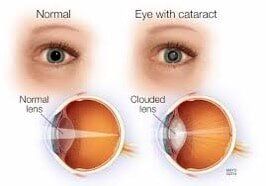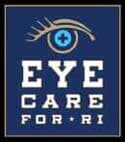What is a cataract?

Today, cataracts affect more than 22 million Americans age 40 and older.
Types of cataracts:
- A subcapsular cataract occurs at the back of the lens. People with diabetes or those taking high doses of steroid medications have a greater risk of developing a subcapsular cataract.
- A nuclear cataract forms deep in the central zone (nucleus) of the lens. Nuclear cataracts usually are associated with aging.
- A cortical cataract is characterized by white, wedge-like opacities that start in the periphery of the lens and work their way to the center in a spoke-like fashion. This type of cataract occurs in the lens cortex, which is the part of the lens that surrounds the central nucleus.
What Causes Cataracts?
The lens inside the eye works much like a camera lens, focusing light onto the retina for clear vision. It also adjusts the eye's focus, letting us see things clearly both up close and far away.
The lens is mostly made of water and protein. The protein is arranged in a precise way that keeps the lens clear and lets light pass through it.
But as we age, some of the protein may clump together and start to cloud a small area of the lens. This is a cataract, and over time, it may grow larger and cloud more of the lens, making it harder to see.
Some Cataract risk factors:
- Family History
- Diabetes
- UV radiation
- Hypertension
- Obesity
- Smoking
After cataract evaluation, the patient is scheduled for their surgery appointments which consist of: pre-operative, surgery and post-operative. Please review cataract surgery information packet prior to your pre-operative appointment.
Current contact lenses must stop wearing their contacts prior to their pre-operative appointment.
- Minimum two weeks for soft lens
- Minimum 1 month for RGP lens (Hard lens)
Pre-operative appointment:
- Lens measurement with the IOL
- OPD test for lens options
- Lens selection
- Surgery kit and directions
Post-Operative Appointment
- Day post-surgery.
- Month post-surgery.
- As required post-surgery per doctor recommendation
Surgery:
Dr. Collins performs surgery at the East Bay Surgery, located at 440 Swansea Mall Drive Swansea, MA 02777. East Bay Surgery Center is a state-of-the-art outpatient surgical center that was designed, equipped and staffed to provide the highest quality surgical care.
For further assistance, please contact their office at 508-324-1171.
Please contact their office for surgery billing questions. East Bay Surgery Center will access a fee for surgery facility charge and anesthesia.
Cataract advanced technology lens options
Traditional monofocal lenses focus light to only one point in space. This lens implant moves inside as the eye’s focusing muscle contracts, mimicking the eye’s natural ability to focus. An accommodative lens is able to provide vision at multiple distances: near, intermediate and distance vision. This is an option for patients who have both cataracts and presbyopia. This lens option reduces the dependency on glasses.
PanOptix Trifocal IOL
This is a multifocal IOL that is designed for active lifestyles from viewing mobile devices and computer screens to providing great distance vision in a variety of lighting solutions. Traditional monofocal lenses focus light to only one point in space. A multifocal lens implant focuses light from distance and near simultaneously. This feature addresses both distance and near vision and reduces the dependency on glasses significantly. Some patients do notice glare symptoms with night driving, but we screen for suitability for in all patients.
Vivity Lens
This latest advanced technology intraocular lens was released in the United States in August 2020. It is the best for computer distance and beyond, but it also enhances reading vision as well. It is built on a current platform that we regularly use that has been implanted in more than 120 million eyes around the world. It does not work as well for reading as the PanOptix lens, but typically has less glare symptoms. Both options significantly reduce dependence on glasses.
Toric
Toric advanced technology lenses corrects astigmatism (blurred vision due to the inability of the eye to focus a point object into a sharp image), as well as myopia (nearsightedness) and hyperopia (farsightedness).











